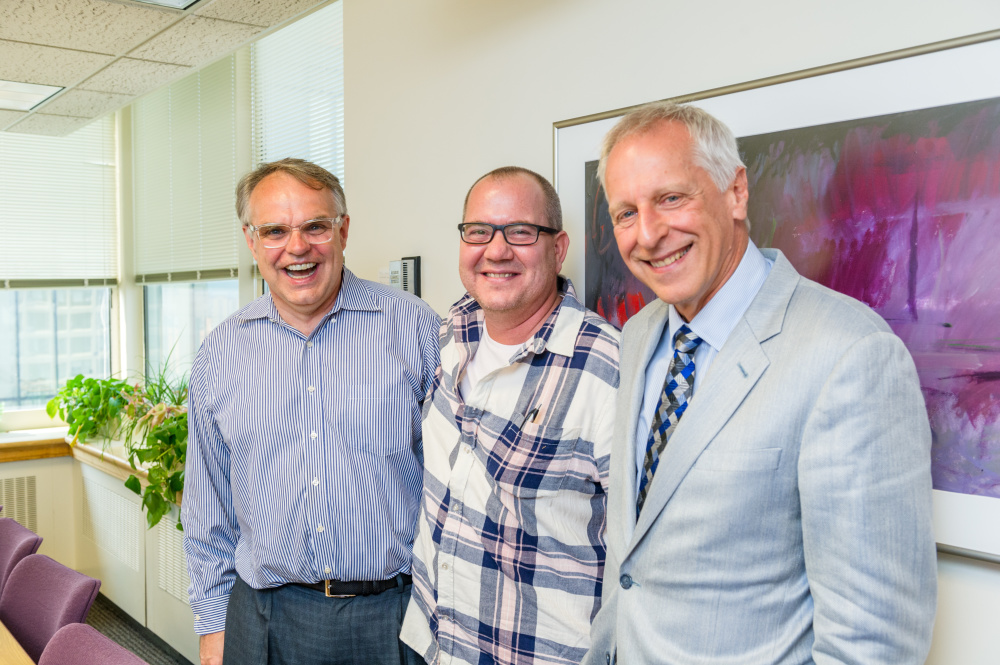
Twenty years to the day after undergoing the stem cell transplant that saved him, Todd Ellison reunited with the Dana-Farber caregivers who changed his life – in more ways than one.
Ellison, who was diagnosed with chronic myelogenous leukemia (CML) in his early 20s, shared handshakes and “thank you” cake with his doctors Joseph Antin, MD, and Hanno Hock, MD, PhD. Accompanied by his brother, Jack, and a fellow transplant recipient he has befriended, Ellison credited Antin, Hock, and nurse practitioner Toni Dubeau, NP, of the Adult Stem Cell Transplantation Program at Dana-Farber/Brigham and Women’s Cancer Center (DF/BWCC) for inspiring him to go back to college and become a social worker after his transplant. Now, Ellison counsels other cancer patients and fights for their rights as an advocate with the Livestrong Foundation, Leukemia & Lymphoma Society, and Be The Match national marrow donor program.
“Having a stem cell transplant makes you reevaluate things,” says Ellison. “I had a good career, but I started to think – am I living a life, or just sort of doing one?”
The group laughed as they recalled the time Ellison, who was in isolation at home after his transplant, asked Hock if he could go out to see the movie “Titanic.” Hock said no, since his immune system was too compromised to be around big crowds. Then, after getting his doctors’ permission, a resourceful social worker surprised Ellison by arranging for a theater to hold a private 8 a.m. screening for him and a few close friends and family members.
Learn More:
“Todd could be very persuasive,” Hock says with a smile, “but everything turned out fine. It’s been wonderful to stay in touch through the years and see how fantastic things have turned out for him.”
Ellison, 45, admits he initially never thought he would live long after his diagnosis. Antin says the median survival for CML in 1997 was three years, but has steadily increased due to new drug regimens and research developed at Dana-Farber and elsewhere.
“We primarily focus more on one – to three-year outcomes; once you get beyond that point, problems like infections and graft-versus-host-disease (GVHD) and relapses tend to fall off and patients become stable,” says Antin, chief of the adult stem cell transplant program. “They don’t need to come see us as much, and can go on with their lives as Todd has done. That is our goal.”
Dubeau believes Ellison’s upbeat attitude during his transplant period, and the infections he endured shortly thereafter, may have something to do with his positive outcome.
“Laughter had a huge presence on the transplant unit, and I think that it was important especially given that we were dealing with such challenging times,” says Dubeau, who now treats Waldenström’s Macroglobulinemia patients. “For most patients, it definitely helped. I have seen or communicated with Todd occasionally over the years, and have loved following his life.”
In addition to his career as a social worker, Ellison’s “second” life has included a free week-long summer camp program he organizes each year for children affected by cancer, and a new vocation as a flight attendant. He also sought out his stem cell donor, meeting up with him on the field before a Pawtucket Red Sox baseball game as Hock and thousands of fans cheered on the reunion.
“I’m always looking for another adventure,” says Ellison.
Learn about stem cell donation from Dana-Farber.
